Lyons W.C. (ed.). Standard handbook of petroleum and natural gas engineering.2001- Volume 1
Подождите немного. Документ загружается.

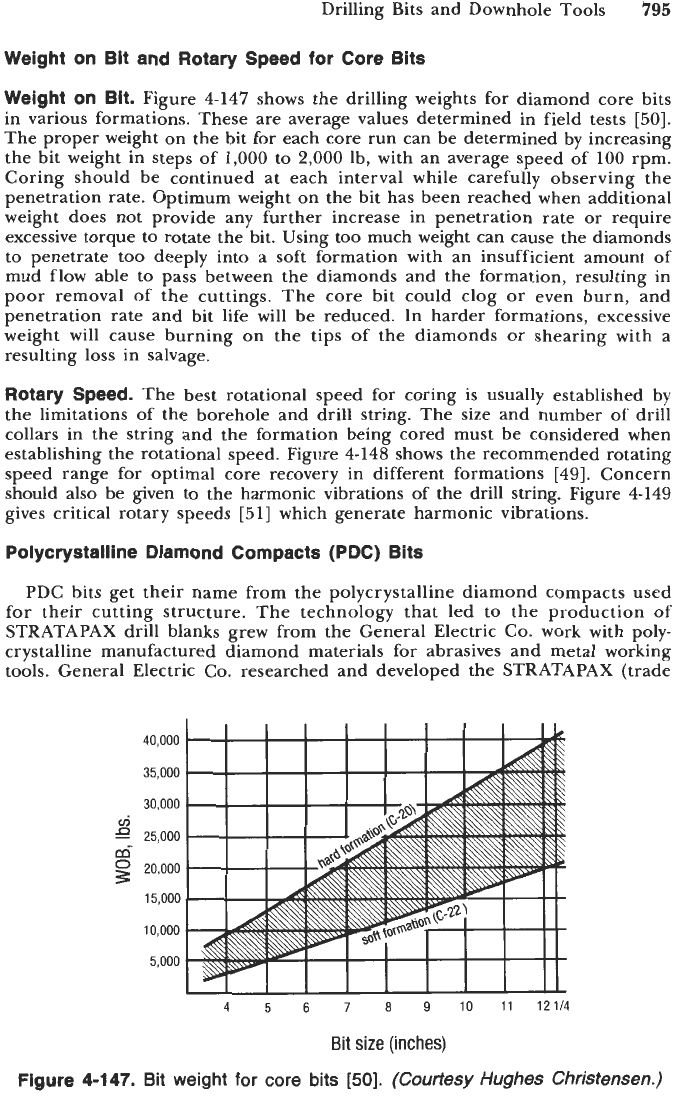
Drilling Bits and Downhole Tools
795
Weight on Bit and Rotary Speed for Core Bits
Weight on Bit.
Figure
4-147
shows the drilling weights for diamond core bits
in various formations. These are average values determined in field tests
[50].
The proper weight on the bit for each core run can be determined by increasing
the bit weight in steps of
1,000
to
2,000
lb, with an average speed of
100
rpm.
Coring should be continued at each interval while carefully observing the
penetration rate. Optimum weight on the bit has been reached when additional
weight does not provide any further increase in penetration rate or require
excessive torque to rotate the bit. Using too much weight can cause the diamonds
to penetrate too deeply into a soft formation with an insufficient amount
of
mud flow able to pass between the diamonds and the formation, resulting in
poor removal of the cuttings. The core bit could clog or even burn, and
penetration rate and bit life will be reduced. In harder formations, excessive
weight will cause burning on the tips of the diamonds or shearing with a
resulting loss in salvage.
Rotary Speed.
The best rotational speed for coring is usually established by
the limitations of the borehole and drill string. The size and number of drill
collars in the string and the formation being cored must be considered when
establishing the rotational speed. Figure
4-148
shows the recommended rotating
speed range for optimal core recovery in different formations
[49].
Concern
should also be given to the harmonic vibrations of the drill string. Figure
4-149
gives critical rotary speeds
[51]
which generate harmonic vibrations.
Polycrystalline Diamond Compacts (PDC) Bits
PDC bits get their name from the polycrystalline diamond compacts used
for their cutting structure. The technology that led to the production of
STRATAPAX drill blanks grew from the General Electric
Co.
work with poly-
crystalline manufactured diamond materials for abrasives and metal working
tools. General Electric
Co.
researched and developed the STRATAPAX (trade
vj
P
4
5
6
7
8
9
10
11
121/4
Bit
size
(inches)
Figure
4-147.
Bit weight
for
core bits
[50].
(Courtesy Hughes Christensen.)

796
Drilling and Well Completions
4oy
I I
I
I
I
1
I
Figure
4-148.
Recommended
rotary
speed
for
core
bits
[49].
(Courtesy
Hughes Christensen.)
name) drill blank in
1973
and Christensen, Inc. used these in PDC bit field tests.
The bits were successfully applied in offshore drilling in the North Sea area in
the late
1970s
and in on-shore areas in the United States in the early
1980s.
In
some areas, the PDC bits have out-drilling roller rock bits, reducing overall cost
per foot by
30
to
50%
and achieving four times the footage per bit at higher
penetration rates
[52,53].
Figure
4-150
shows the major components and design of the PDC bit. The
polycrystalline diamond compacts, shown in Figure
4-15
1.
The polycrystalline
diamond compacts (of which General Electric's) consist of a thin layer of
synthetic diamonds on a tungsten carbide disk. These compacts are produced
as an integral blank by a high-pressure, high-temperature process. The diamond
layer consists of many tiny crystals grown together at random orientations for
maximum strength and wear resistance.
The tungsten carbide backing provides mechanical strength and further
reenforces the diamond compact wear-resistant properties. During drilling, the
polycrystalline diamond cutter wears down slowly with a self-sharpening effect.
This helps maintain sharp cutters for high penetration-rate drilling throughout
the life of the bit.
PDC
Bit
Design.
Figures
4-152
and
4-153
show typical PDC bits. Figure
4-152
is for soft formation. Figure
4-153
is for hard and abrasive formation
[43A].
Bit
Body
Material
(Matrix).
There are two common body materials for PDC
bits, steel and tungsten carbide. Heat-treated steel body bits are normally a "stud"
bit design, incorporating diamond compacts on tungsten carbide posts. These
stud cutters are typically secured to the bit body by interference fitting and
shrink fitting. Steel body bits also generally incorporate three or more carbide
nozzles (often interchangeable) and carbide buttons on gauge. Steel body bits
have limitations of erosion of the bit face by the drilling mud and wear of the
gauge section. Some steel body bits are offered with wear-resistant coatings
applied to the bit face to limit mud erosion.
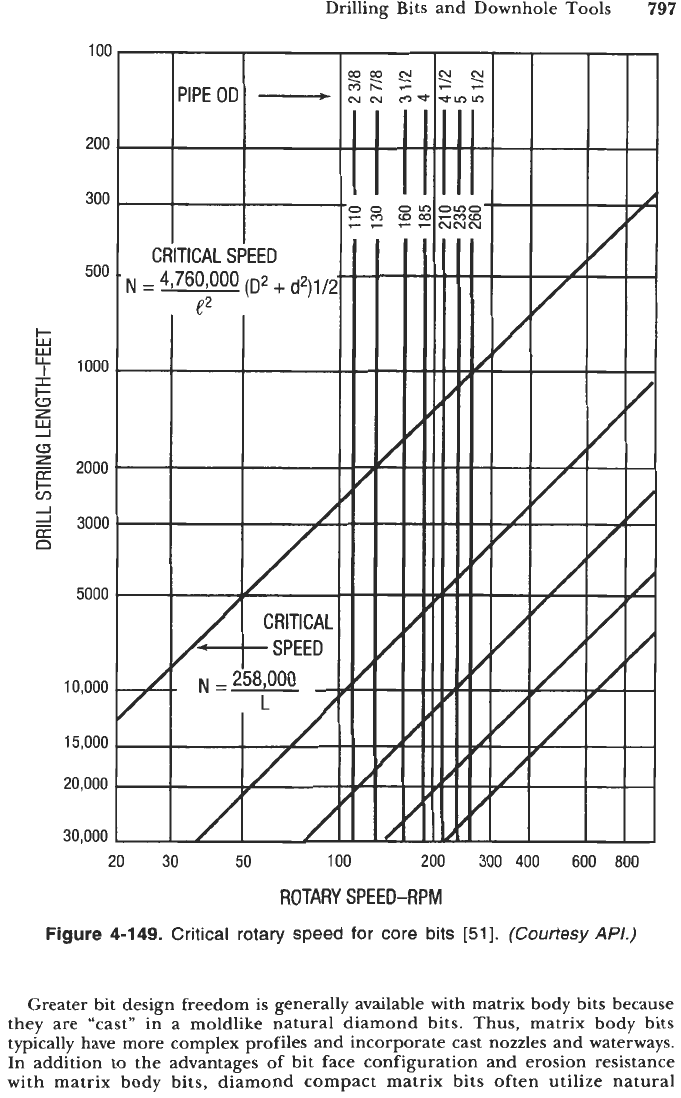
Drilling Bits and Downhole Tools
797
100
200
300
500
L
y
1000
5
w
I
I-
c3
J
L3
I-
v)
J
CT
g
2000
1
3000
n
5000
10,000
15,000
20,000
30,000
I
I
CRITICALSPEED
I
I
20
30
50
100
200
300
400
600
800
ROTARY SPEED-RPM
Figure
4-149.
Critical rotary
speed
for
core
bits
[51].
(Courtesy
API.)
Greater bit design freedom is generally available with matrix body bits because
they are “cast” in a moldlike natural diamond bits. Thus, matrix body bits
typically have more complex profiles and incorporate cast nozzles and waterways.
In addition to the advantages of bit face configuration and erosion resistance
with matrix body bits, diamond compact matrix bits often utilize natural
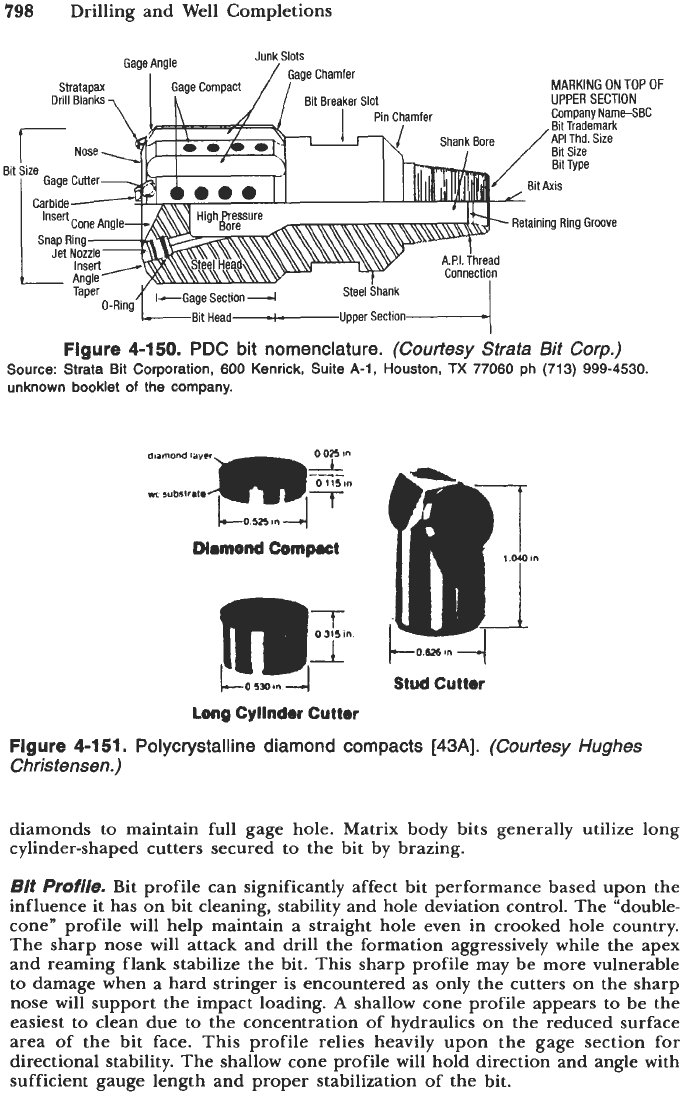
798
Drilling and Well Completions
P
OF
BC
Bit
Figure
4-150.
PDC bit nomenclature.
(Courtesy Strata Bit
Corp.)
Source: Strata Bit Corporation, 600 Kenrick, Suite
A-I,
Houston,
TX
77060 ph (713)
999-4530.
unknown booklet
of
the
company.
&O
330,"
4
Long
Cyllndor
Cuttor
t--0.624
In
1
Stud Cutter
Figure
4-1 51.
Polycrystalline diamond compacts
[43A].
(Courtesy Hughes
Christensen.)
diamonds to maintain full gage hole. Matrix body bits generally utilize long
cylinder-shaped cutters secured to the bit by brazing.
Bit
frofi/e.
Bit profile can significantly affect bit performance based upon the
influence it has on bit cleaning, stability and hole deviation control. The "double-
cone" profile will help maintain a straight hole even in crooked hole country.
The sharp nose will attack and drill the formation aggressively while the apex
and reaming flank stabilize the bit. This sharp profile may be more vulnerable
to damage when a hard stringer
is
encountered as only the cutters on the sharp
nose will support the impact loading.
A
shallow cone profile appears to be the
easiest to clean due to the concentration of hydraulics on the reduced surface
area of the bit face. This profile relies heavily upon the gage section for
directional stability. The shallow cone profile will hold direction and angle with
sufficient gauge length and proper stabilization of the bit.
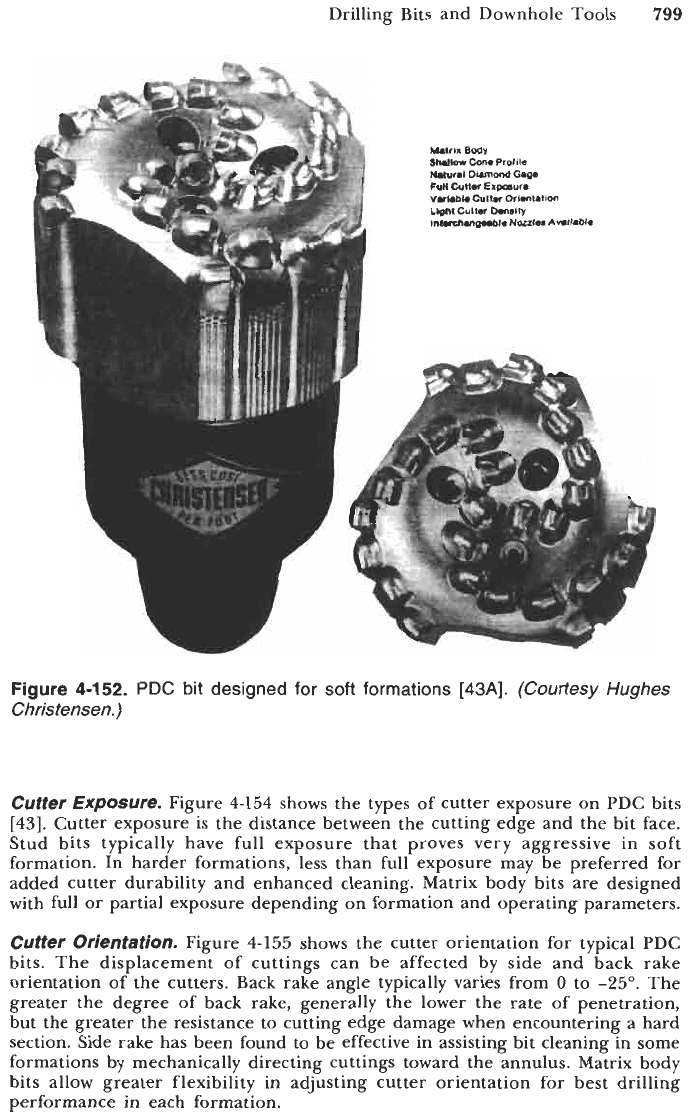
Drilling Bits and Downhole
Tools
799
Figure
4-152.
PDC
bit designed for
soft
formations
[43A].
(Courtesy
Hughes
Christensen.)
Cutter Exposure.
Figure
4-154
shows the types of cutter exposure on PDC bits
[43].
Cutter exposure is the distance between the cutting edge and the bit face.
Stud bits typically have full exposure that proves very aggressive in soft
formation. In harder formations, less than full exposure may be preferred for
added cutter durability and enhanced cleaning. Matrix body bits are designed
with full or partial exposure depending on formation and operating parameters.
Cutter Orientation.
Figure
4-155
shows the cutter orientation for typical PDC
bits. The displacement of cuttings can be affected by side and back rake
orientation of the cutters. Back rake angle typically varies from
0
to
-25".
The
greater the degree of back rake, generally the lower the rate of penetration,
but the greater the resistance to cutting edge damage when encountering a hard
section. Side rake has been found to be effective in assisting bit cleaning in some
formations by mechanically directing cuttings toward the annulus. Matrix body
bits allow greater flexibility in adjusting cutter orientation for best drilling
performance in each formation.
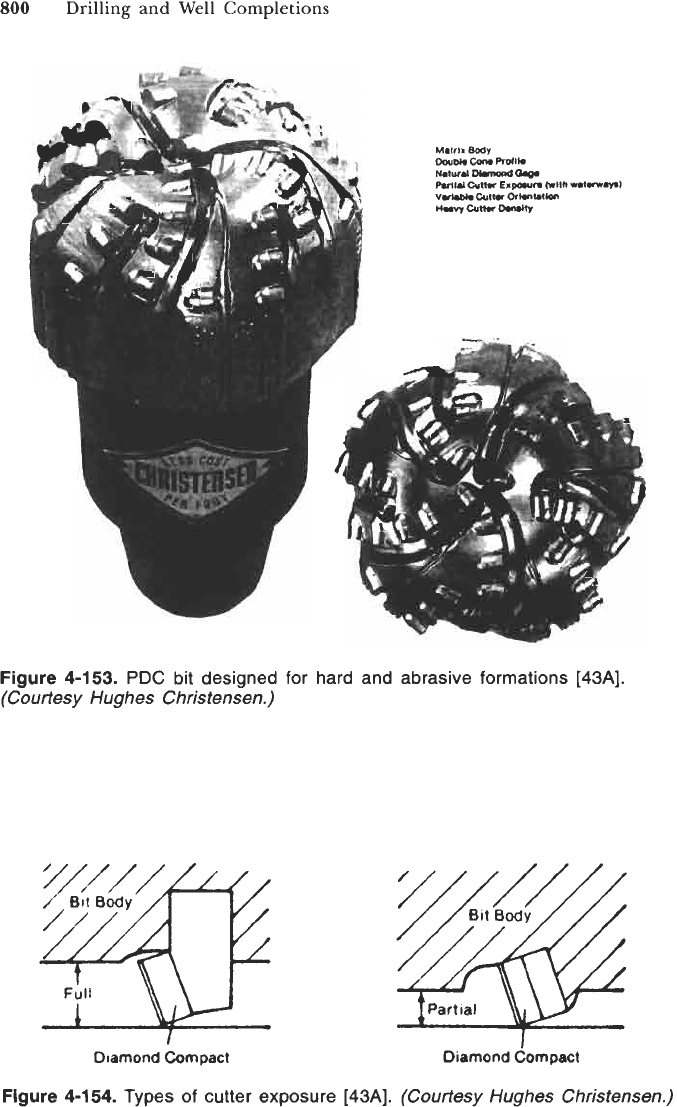
800
Drilling and Well Completions
Figure 4-153.
PDC
bit designed
for
hard and abrasive formations
[43A].
(Courtesy Hughes Christensen.)
I
Diamond Compact Diamond Compact
Figure 4-1 54. Types
of
cutter exposure
[43A].
(Courtesy Hughes Christensen.)
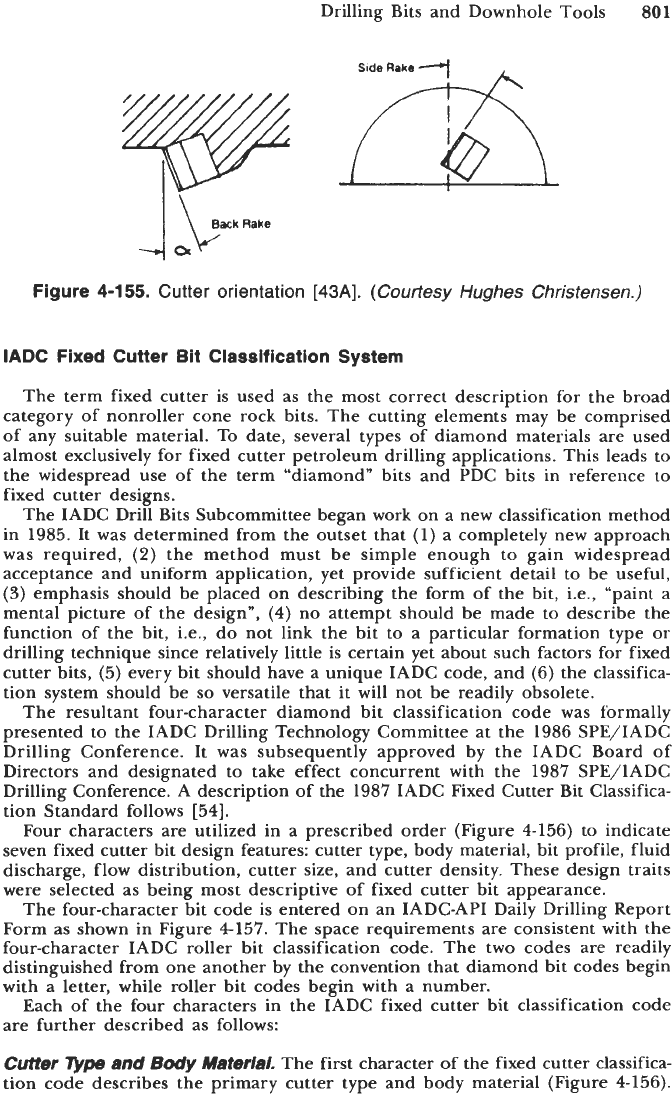
Drilling Bits and Downhole Tools
801
Figure
4-155.
Cutter orientation
[43A].
(Courtesy
Hughes
Christensen.)
IADC
Fixed Cutter Bit Classification System
The term fixed cutter is used as the most correct description for the broad
category of nonroller cone rock bits. The cutting elements may be comprised
of any suitable material. To date, several types of diamond materials are used
almost exclusively for fixed cutter petroleum drilling applications. This leads to
the widespread use of the term “diamond” bits and PDC bits in reference to
fixed cutter designs.
The IADC Drill Bits Subcommittee began work on a new classification method
in
1985.
It was determined from the outset that
(1)
a completely new approach
was required,
(2)
the method must be simple enough to gain widespread
acceptance and uniform application, yet provide sufficient detail to be useful,
(3)
emphasis should be placed on describing the form of the bit, i.e., “paint a
mental picture of the design”,
(4)
no attempt should be made to describe the
function of the bit, i.e., do not link the bit to a particular formation type or
drilling technique since relatively little is certain yet about such factors for fixed
cutter bits,
(5)
every bit should have a unique IADC code, and
(6)
the classifica-
tion system should be
so
versatile that it will not be readily obsolete.
The resultant four-character diamond bit classification code was formally
presented to the IADC Drilling Technology Committee at the
1986
SPE/IADC
Drilling Conference. It was subsequently approved by the IADC Board of
Directors and designated to take effect concurrent with the
1987
SPE/IADC
Drilling Conference. A description of the
1987
IADC Fixed Cutter Bit Classifica-
tion Standard follows
[54].
Four characters are utilized in a prescribed order (Figure
4-156)
to indicate
seven fixed cutter bit design features: cutter type, body material, bit profile, fluid
discharge, flow distribution, cutter size, and cutter density. These design traits
were selected as being most descriptive of fixed cutter bit appearance.
The four-character bit code is entered on an IADC-API Daily Drilling Report
Form as shown in Figure
4-157.
The space requirements are consistent with the
four-character IADC roller bit classification code. The two codes are readily
distinguished from one another by the convention that diamond bit codes begin
with a letter, while roller bit codes begin with a number.
Each
of
the four characters in the IADC fixed cutter bit classification code
are further described as follows:
Cutter
TLpe
and
Body
Material.
The first character of the fixed cutter classifica-
tion code describes the primary cutter type and body material (Figure
4-156).
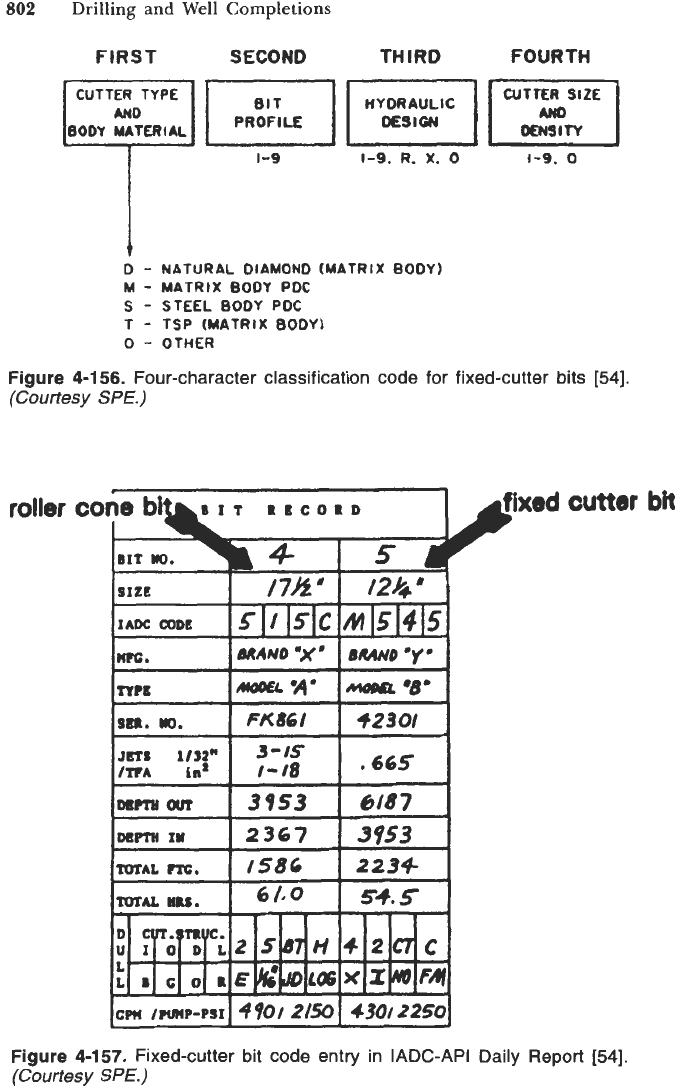
802
Drilling and Well Completions
FIRST
SECOND
THIRD
FOURTH
CUTER
SIZE
1-9.
0
HYDRAULIC
1-9
1-9.
R.
X.
0
t
D
-
NATURAL RIAMONO (MATRIX BODY)
M
-
MATRIX
BOOY
POC
S
-
STEEL
BODY
PQC
T
-
TSP
(MATRIX
80DYl
0
-
OTHER
Figure
4-1
56.
Four-character classification code for fixed-cutter bits
[54].
(Courtesy
SPE.)
roller
co
xed
cutter
bit
Figure
4-157.
Fixed-cutter bit code entry in IADC-API Daily Report
[54].
(Courtesy
SPE.)

Drilling Bits and Downhole Tools
803
C
-CONE
HEIGHT
WlOW
UEDIVY
LOW
G-GAGE
WEIGHT
’
c
>
1/40
1/80
S
C
6
1/40
C
<
I/8D
1
2
3
4
5
6
9
HIM
Q>3/80
UED
1/80
S
G
S
JMO
LOW
0
<
1/80
-
Five letters are presently defined: D-natural diamond/matrix body, M-PDC/
matrix body, S-PDC/steel body, T-TSP/matrix body, 0-other.
The term PDC is defined as “polycrystalline diamond compact.” The term
TSP
is defined as “thermally stable polycrystalline” diamond. TSP materials are
composed of manufactured polycrystalline diamond which has the thermal
stability of natural diamond. This is accomplished through the removal of trace
impurities and in some cases the filling
of
lattice structure pore spaces with a
material
of
compatible thermal expansion coefficient.
The distinction of
primary
cutter types is made because fixed cutter bits often
contain a variety of diamond materials. Typically one type of diamond is used
as the primary cutting element while another type
is
used as backup material.
Profile.
The numbers
1
through
9
in the second character
of
the fixed cutter
classification code refer to the bit’s cross-sectional profile (Figure
4-158).
The
BIT
PROFILE
CODES
WILL
BIT
CORE
BIT
0:
00-10
Figure
4-158.
Bit
profile codes
for
fixed
cutter bits
[54].
(Courtesy
SPE.)
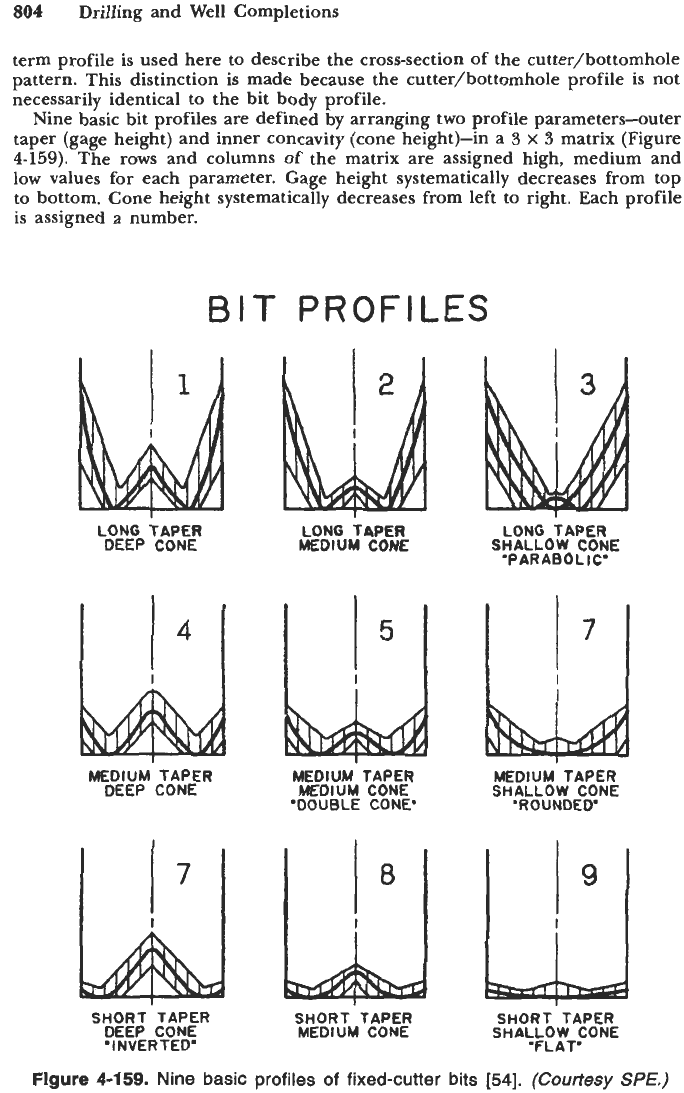
804
Drilling and Well Completions
term profile is used here
to
describe the cross-section
of
the cutter/bottomhole
pattern. This distinction is made because the cutter/bottomhole profile is not
necessarily identical
to
the bit body profile.
Nine basic bit profiles are defined by arranging
two
profile parameters-outer
taper (gage height) and inner concavity (cone height)-in a
3
x
3
matrix (Figure
4-159).
The
rows
and columns of the matrix are assigned high, medium and
low values for each parameter. Gage height systematically decreases from top
to bottom. Cone height systematically decreases from left to right. Each profile
is assigned a number.
BIT
PROFILES
LONG
TAPER
DEEP CONE
MEDIUM
TAPER
DEEP
CONE
7
I
SHORT
TAPER
PEEP CONE
INVERTED'
LONG
TAPER
MEDIUM
CONE
MEDIUM
TAPER
MEDIUM
CONE
'DOUBLE
CONE'
SHORT
TAPER
MEDIUM
CONE
MEDIUM
TAPER
SHALLOW
CONE
'ROUNDED'
9
I
SHORT TAPER
SHALLOW
CONE
'FLAT'
Figure
4-159.
Nine basic profiles of fixed-cutter bits
[54].
(Courtesy SPE.)
